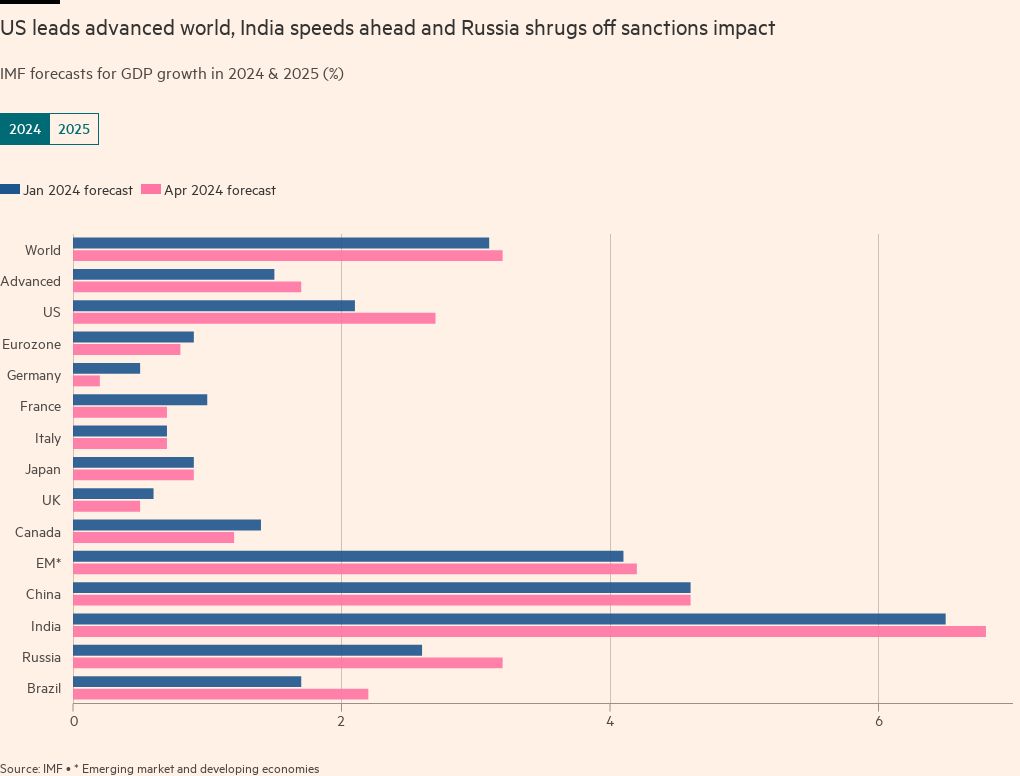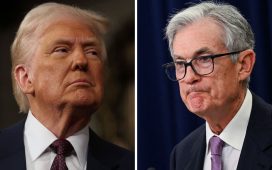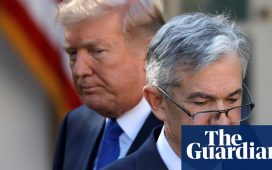Stay informed with free updates
Simply sign up to the US economy myFT Digest — delivered directly to your inbox.
The US is on track to grow at double the rate of any other G7 country this year, according to IMF forecasts, as the strength of the world’s biggest economy rocks global markets.
Strong household spending and investment will help propel US growth to 2.7 per cent this year according to the fund’s latest World Economic Outlook.
The figure is higher than the 2.5 per cent estimated for 2023 and represents a 0.6 percentage point upgrade on the previous forecast.
The projections highlight the US economy’s role as the driver of global growth, as investors across the world scale back their expectations for Federal Reserve interest rate cuts.
The IMF said the next best performer in the G7 this year would be Canada, with growth of 1.2 per cent.
It added that Germany’s expansion would be the weakest among the G7 at 0.2 per cent. Japan is forecast to experience growth of 0.9 per cent, while the UK is set to expand by just 0.5 per cent after flatlining in 2023.
Global stock markets sank and Asian currencies were hit by a rising dollar on Tuesday, following a Wall Street sell-off prompted by strong US retail sales figures suggesting the Fed may cut rates this year by less than previously thought.
Pierre-Olivier Gourinchas, IMF chief economist, told the Financial Times that, while the “baseline” was still three quarter-point cuts this year, the Fed could be thrown off course by the surging US economy.
“If the inflation pressures persist beyond what we have right now, in the US in particular, then we would expect that they would have later cuts and maybe fewer cuts,” he said.
The Stoxx Europe 600 index fell 1.6 per cent in afternoon trading, while the US S&P 500 opened marginally lower following the previous day’s losses. Shifting US rate expectations also hit currency markets, pushing the Indian rupee to a record low and the Indonesian rupiah to its weakest in four years against the dollar.
Gourinchas added that Fed rate cuts could be delayed from this summer to the fourth quarter — potentially after November’s presidential election — if inflation overshot IMF expectations.
At present, investors expect the Fed to cut rates by September and possibly more than once by the end of the year.
The recent bumper US growth has helped the global economy avoid a long-feared hard landing following interest rate rises.
But strong demand has also pushed up price pressures, in contrast with the UK and eurozone.
The IMF said US inflation would continue to recede but lifted its forecast for this year to 2.9 per cent, above the 2.4 per cent predicted for the eurozone and 2.5 per cent in the UK.
Gourinchas said the European Central Bank and the Bank of England could cut rates sooner because they did not face such a “strong demand-driven component of inflation”.
Laying out its projections as central bank governors and finance ministers attend joint IMF/World Bank spring meetings in Washington, the fund found that global economic activity had proven “surprisingly resilient” even after central banks boosted rates to bear down on inflation.
But it also warned of risks to the global recovery, notably the possibility of fresh increases in commodity prices resulting from the conflict in the Middle East.
The broader picture is still one of tepid expansion by historical standards, with world growth projected to remain at 3.2 per cent this year and next, in line with 2023’s estimate.
The IMF said the long-term consequences of the coronavirus pandemic, Russia’s full-scale invasion of Ukraine, weak productivity growth and increasing “geoeconomic fragmentation” were hampering expansion.
The cause of disinflation in advanced economies was being aided by a stronger than forecast rise in employment, in part because of inflows of migrants, the IMF said. There had been faster growth in foreign-born rather than domestic workforces since 2021 in economies including Canada, the eurozone, the UK and the US, it found.
Among other leading economies, the IMF predicted China’s growth would slow this year to 4.6 per cent from 5.2 per cent in 2023, while forecasts for India, one of the world’s fastest-growing economies, have been upgraded to 6.8 per cent for this year.
Russia received one of the biggest upgrades, with growth now projected to be 3.2 per cent this year, 0.6 percentage points higher than previously expected, followed by growth of 1.8 per cent in 2025. The IMF’s doubling of its forecast for Russian growth in its January outlook fed concerns among G7 countries that sanctions were failing to damage Vladimir Putin’s war economy.
Gourinchas said Russian expansion was being partly driven by strong oil export revenues, coupled with firm private investment.
“Domestic demand is very strong,” he said. “The sanctions are still degrading and having an impact gradually on the Russian economy, but the economy itself is quite resilient.”









